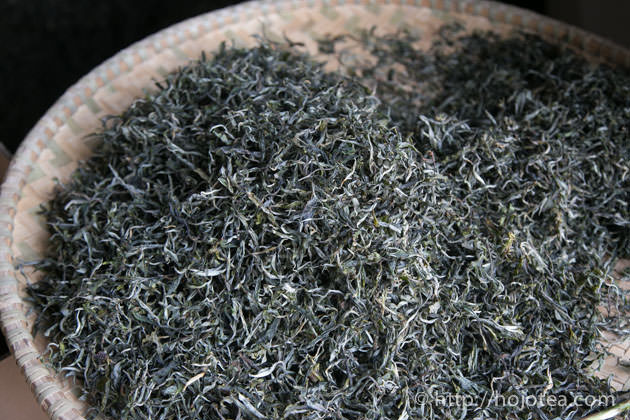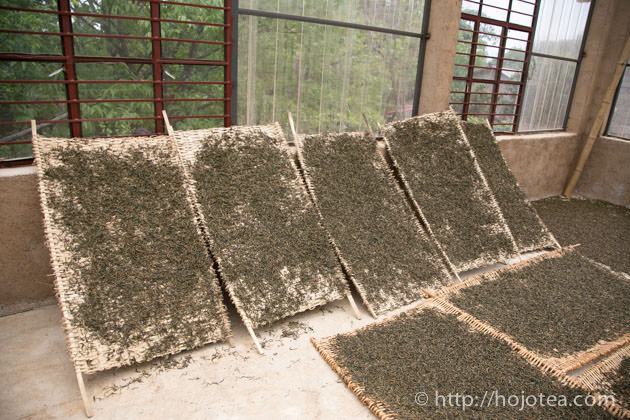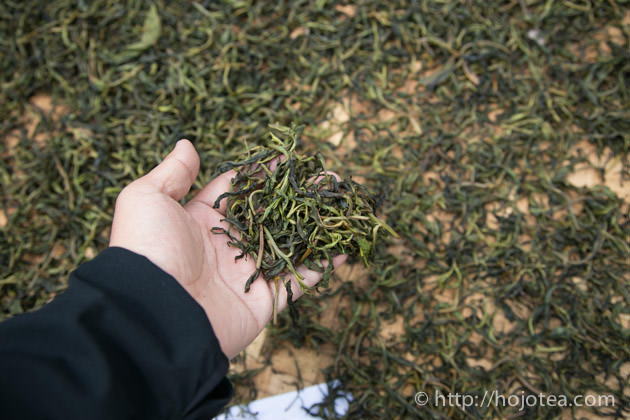- HOME >
- Tea Processing
Drying process that affects the flavor of raw pu-erh tea
Pu-erh tea consists of raw pu-erh tea and ripe pu-erh tea. The tea leaf of raw pu-erh tea is greenish color and the drinking feeling is closer to green tea or white tea. In fact, raw pu-erh tea is technically one kind of green tea. The basic process of both raw pu-erh tea and green tea is the same as described below:
- Withering
- Pan-frying (Inactivation of Enzyme)
- Rolling
- Drying
The only difference between green tea and pu-erh tea is the drying method
The difference between green tea and pu-erh tea is the drying method. The green tea is dried with hot air in general, while pu-erh tea is dried under the sun. Thanks to the sunshine drying, it develops distinctive drinking feeling of pu-erh tea.
As for the ripe pu-erh tea, it is microbiologically fermented tea made using raw pu-erh tea as raw material. The ripe pu-erh tea has a shorter history. Its production method was developed in 1970s.
In making raw pu-erh tea, any tea manufacturer in Yunnan only uses sunshine drying method
I often come across with customer loudly told me that nowadays some tea factories use hot air drying to replace the traditional sunshine drying method. However, it is nothing but incorrect information given by those who have never been to the tea production site. In any occasion, the tea factories have no reason to use hot air drying instead of sunshine drying that cost is zero. If they use hot air drying, it becomes a green tea and moreover the production cost will be very high. In Yunnan, all the tea manufacturers, regardless of big or small scale, use sunshine drying for making pu-erh tea.
Weather is the very important element that affects the flavor of tea
Sunshine drying is the simplest way of drying. However, it often affects the tea quality if the weather is not very ideal. Most of the pu-erh tea production area in Yunnan is located at more than 1000m a.s.l.. During sunny day, tea is dried within half a day. However, tea will remain wet even after been dried for a whole day if the weather is not fine, raining or continuously cloudy. Under the circumstances, tea leaf becomes darker and less shinny. It produces unpleasant odor too. It is just like wet laundry is kept for a whole day during raining day. Once the unpleasant odor is formed, it will not disappear, even after tea is further dried on subsequent day. Therefore, it is very critical to choose the tea produced during the fine weather. Tea must be properly and sufficiently dried under the fine weather.

The environment to conduct sunshine drying is also important. In this photo, the tea leaf was placed at the road side for drying. From my point of view, it is not the ideal environment.
We select tea before blending
In a day, the manufacturer produces many batches of tea. It is because of each frying-pan can only accommodate very small quantity of tea leaves. Moreover, day by day the drying condition of tea leaves vary a lot. The quality of tea is mostly affected by the weather condition and the tea master frying skill. So usually the standard practice is that the manufacturer continuously producing the 1st plucked tea for about a week, and then all batches are blended in order to even out the quality. Since we are very particular about the condition of tea leaf, we always make sure select individual batch of tea before the blending is conducted. That is the reason why we always has to be at the production site even before the tea production is started. We have to put emphasis on the tea manufacturer so as not to blend the different batches of tea.
Related Articles
How to get the latest update on HOJO?
1. Follow Twitter, 2. Click "Like" on Facebook, and 3. Subscribe in newsletter. You can have the latest tea news from HOJO.
 Subscribe the Newsletter to enjoy the privileges
Subscribe the Newsletter to enjoy the privileges- You may receive a free sample upon purchase, or you may have the priority to purchase special products. So please remember to subscribe our newsletter as well as the social network.
- Myanmar White Tea Bud 2013 from Guo Gan, Myanmar
- We have released a raw Pu-erh tea, 緬甸白芽茶 2013 (Myanmar White Tea Bud 2013), produced by ethnic minorities in t …
- Yong De Wild White Tea 2025 Loose Leaf Limited Release
- We have released Yong De Wild White Tea Loose 2025. For the 2025 harvest, only the loose-leaf type was …
NEW ARTICLES
 Myanmar White Tea Bud 2013 from Guo Gan, Myanmar
Myanmar White Tea Bud 2013 from Guo Gan, Myanmar- We have released a raw Pu-erh tea, 緬甸白芽茶 2013 (Myanmar White Tea Bud 2013), produced by ethnic minorities in t …
 Yong De Wild White Tea 2025 Loose Leaf Limited Release
Yong De Wild White Tea 2025 Loose Leaf Limited Release- We have released Yong De Wild White Tea Loose 2025. For the 2025 harvest, only the loose-leaf type was …
 Experience the True Freshness of Raw Pu-erh : Tang Jia 2025 Loose Leaf Release
Experience the True Freshness of Raw Pu-erh : Tang Jia 2025 Loose Leaf Release- We have released Tang Jia Raw Pu-erh Tea 唐家古樹生茶 2025 Loose Leaf. Among HOJO’s raw pu-erh teas, Tang Jia Raw Pu …
 Yunnan Chun Jian Green Tea from High Mountain Gardens
Yunnan Chun Jian Green Tea from High Mountain Gardens- Yunnan Chun Jian Green Tea is now available. This tea is made from naturally grown leaves harvested from high …
 Limited Loose Leaf Release of 2025 Da Xue Shan Wild Raw Pu-erh Tea
Limited Loose Leaf Release of 2025 Da Xue Shan Wild Raw Pu-erh Tea- We have released the 2025 loose-leaf version of Da Xue Shan Wild Raw Pu-erh Tea. This tea comes from wild tea …
 Discover a New Way to Enjoy Tea: Cooking Rice with Tea
Discover a New Way to Enjoy Tea: Cooking Rice with Tea- Cooking rice with tea is a simple idea, but it brings surprisingly satisfying results. The tea’s flavour seeps …
 2025 Da Xue Shan Wild White Tea Now Available from Yunnan
2025 Da Xue Shan Wild White Tea Now Available from Yunnan- The 2025 harvest of Da Xue Shan Wild White Tea is now available. Crafted from truly wild Camellia taliensis tr …
 Fresh 2025 Yunnan White Tea – Select Your Favourite Lot Before Blending
Fresh 2025 Yunnan White Tea – Select Your Favourite Lot Before Blending- Freshly crafted in Yunnan and just arrived in KL, our new 2025 white tea is now available at our Gardens Mall …
 2024 Dong Shan Raw Pu-erh Tea – Crafted with the Producer for Desired Quality
2024 Dong Shan Raw Pu-erh Tea – Crafted with the Producer for Desired Quality- We have released the 2024 cake of Dong Shan Raw Pu-erh Tea. Earlier, we offered the loose-leaf version from th …
 Development of Firewood Roasted Hojicha Using Naturally Grown Tea from Yunnan
Development of Firewood Roasted Hojicha Using Naturally Grown Tea from Yunnan- We are currently staying in Yunnan Province for tea production. As the season nears its end, tea trees with pa …
Category
- New Arrival at HOJO Online Shop
- Featured Articles
- Newsletter
- Types of Tea
- Origin of Tea
- Teapot and Tea Equipment
- Tea Column
- How to enjoy tea
- Tea Processing
- How to choose quality tea
- Tea constituents and functional effect
- Safety of Tea
- Foods
- Tea Business Operation
- Hobby and Outdoor Activity
- Ranking of Tea
- Video
- FAQ
- Media Release
Profile

- AKIRA HOJO
- I invite you to experience my tea selections.I was born in Nagano, Japan. In university, I studied agricultural chemistry, and I have the master degree in food science. I worked in Japanese food industry for 10 years. I involved in R&D, QC and QA. As a factory manager, I implemented ISO9000 series and managed the factory.
- The Art of Tea Magazine
- We posted the article on “The Art of Tea Magazine No.9, the magazine is published in Taiwan. We featured …
- New Straits Times
- The Malaysian National Newspaper, New Straits Times featured HOJO Tea on 17-Oct-2007.
Shop Info

Address:Lot No. T-215, 3rd Floor, The Gardens Mall, Mid Valley City, Lingkaran Syed Putra, 59200 Kuala Lumpur
Tel: +603-2287-4537
Business Hour: 10am to 10pm





















